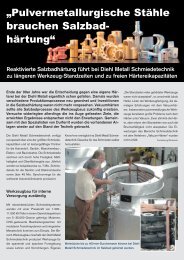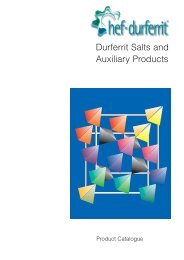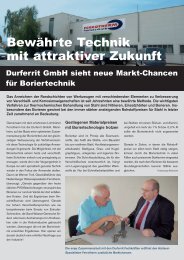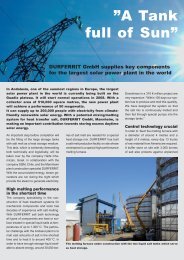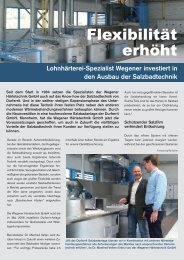TUFFTRIDE®-/QPQ®-PROCESS - Durferrit
TUFFTRIDE®-/QPQ®-PROCESS - Durferrit
TUFFTRIDE®-/QPQ®-PROCESS - Durferrit
You also want an ePaper? Increase the reach of your titles
YUMPU automatically turns print PDFs into web optimized ePapers that Google loves.
Fig. 12<br />
�������� ���� ����� �� ��<br />
Fig. 13<br />
���� �� ������ �� � �� ��� ������� �������<br />
���<br />
���<br />
���<br />
���<br />
���<br />
���<br />
�<br />
��������� �� ��� ������� ��������� �� ��� ���� �� � ������ ���<br />
����<br />
����<br />
The question is often raised as to the wear resistance of<br />
the diffusion layer. Fig. 12 shows a comparison of the<br />
wear behaviour of rocker arms treated by two different<br />
heat treatment processes. It shows the wear on the running<br />
surface of the rocker arm<br />
which run against a salt bath<br />
nitrocarburized camshaft made<br />
���� ��������<br />
���� ��������<br />
��� ��������� �<br />
�������<br />
���������<br />
���� ������� ����<br />
��������� �����<br />
��������� �������<br />
���� �����<br />
��������� � ��������<br />
������ ����<br />
���� �<br />
������� ���� �<br />
����<br />
����<br />
����<br />
� �����������<br />
���� ��� ��� ��<br />
������� �������� �� �<br />
������<br />
�������� ���� ����� �� ����� ���� ���� �������<br />
��������� ����� ������� ���� ���������<br />
���������<br />
���������<br />
��� ���� ��� ����<br />
��������� ����<br />
�������� ��������<br />
���<br />
���<br />
���<br />
���<br />
���<br />
���<br />
�<br />
���������<br />
���������<br />
��� ����<br />
���������<br />
��������<br />
��� ����<br />
����<br />
��������<br />
��������� � �������<br />
from chilled cast iron. Although<br />
the surface hardness of the case<br />
hardened rocker arm was slightly<br />
reduced by nitrocarburizing, the<br />
much improved wear resistance<br />
due to the presence of the compound<br />
layer, to approximately 80<br />
hours running time is clearly visible.<br />
After 70-80 hours, the wear profile<br />
then runs parallel to that of the<br />
case hardened only rocker arm,<br />
which is attributable to the protection<br />
given by the diffusion<br />
layer. A spontaneous increase in<br />
wear after the loss of the compound<br />
layer was not observed.<br />
This test again showed very<br />
impressively that a high surface<br />
hardness does not automatically<br />
mean that the protection<br />
against wear is also very high.<br />
It depends on the respective<br />
wear mechanism involved as to<br />
how a material or material partnering<br />
is to be assessed. Nitrocarburized<br />
running partners<br />
have proved themselves to be<br />
very good under adhesive wear<br />
conditions in particular. Their<br />
tendency to seize is much<br />
lower than that of other surface<br />
layers.<br />
Fig. 13 shows the results according<br />
to Nieman-Rettig of scuffing<br />
load limit tests on gears. These<br />
data were established by applying<br />
torque to the tooth flank<br />
and increasing it until seizure<br />
occurred. Nitrocarburizing by the<br />
TUFFTRIDE ® process raised the<br />
scuffing load limit of the materials<br />
tested by 2-5 times.<br />
9



